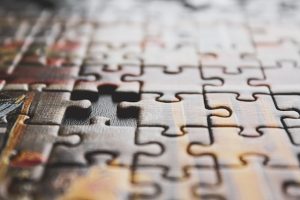
3. Grasping Reality
As I start the second half of this lecture….
I need to remind us all that grasping the “Big Picture” is one thing and then grasping reality is another matter. We are talking about our family’s lives here and they will be complicated. Here is one more side note. I like analogies; they provide vivid word pictures I can relate to. So here is one analogy I like: the reference to a jigsaw puzzle. That is also why you will see scattered puzzle pieces throughout this website. Life can be like a jigsaw puzzle, can’t it?
Suppose you are sitting at a table, and someone unloads a 1000-piece jigsaw puzzle in front of you on the table. You are instructed that you have one hour to assemble it. In good faith you begin the project, however in only fifteen minutes another different 1000-piece puzzle is dropped right on top of the first puzzle with the new instruction that you now have 45 minutes to complete both puzzles. Oh by the way, I am so sorry but there are no master puzzle pictures to follow, just do your best.
Sadly, I can relate to this. Life can be unexpected and extreme. But honestly, it can be handled and in the end the puzzles will look beautiful. I truly believe you are not alone in your journey, so here are some of the realities of our daily family journey.
When our daughter was born, we soon learned that she had delays. Joy was not experiencing the normal stages of infant development one would expect. By the age of two years old, Joy was given the diagnosis of C.P. so that she might receive the O.T., P.T. and speech therapies she needed. There were delays in all areas (gross and fine motor skills, eating, speech, and cognitive development). Therapies began before she was two years old, and progress was slow.
As the years passed, Joy and the family settled into our new routine. We were actually handling things rather well. This however changed on one fateful day. Joy was soon about to turn the age of nine years old. My wife and I were sitting at the kitchen table as Joy was having an afternoon snack. We both noticed a quick and obvious strong head-nod from Joy. What was that? It was indeed a seizure. From that day on our lives were changed. Each and every day Joy had one or more seizures and as the days progressed, so did the number of daily seizures and their strength.
Joy was having what are called drop seizures, so an EEG was ordered to document them, and she was started on an anticonvulsant medication.
However, in only 8 months, Joy had already been increased from one to four different medications, because the medications thus far were not helping. By the 18th month, the seizure activity actually grew in number to over 80 strong drop seizures daily, and this seizure level continued on, for the next 2 ½ years.
We felt as though we were losing her and in hindsight, we were. Our happy child could no longer talk, laugh, or even form a smile. Eating was difficult. There were no other tests ordered other than an EEG. Why were the seizures even in her life? And we were clueless as parents. It is now easy to think back and say we should have asked a whole array of questions a few years prior, but simply making it through each day was our number one challenge and energy drainer.
Honestly, we would have been grateful for an objective counseling relationship with a professional instead of someone to write us a new script. Sorry if you find the comment harsh, but it does mostly convey reality. In the first four-years of our daughter’s Epilepsy treatment, we logged eighty-four new scripts, mostly aimed at futile attempts to control the horrible side effects of the medication. Seizure control was not even at the top of our daily radar screen back then. We needed help just to make it through each day.
Whether or not this next thought has any validity is yours to determine; in hindsight it seems to me the doctors were doing their best, as they waited for Joy to pass away. Her condition was that bad. Lissencephaly is listed as a terminal condition. I believe the doctors simply felt her case was hopeless and perhaps felt it was their duty to treat her as a hospice patient. Looking at the current data, it did seem as if she was close to the end of life.

You see, Joy has been challenged from the day she was born.
Epilepsy is not her main diagnosis; Epilepsy is a result from… “What?”. At that point in time, we did not know. Her main diagnosis was still Cerebral Palsy. Our doctors never shared any information concerning an alternative option other than medications for her seizure activity.
Then fearing for our daughter’s life, we asked about alternative treatments (surgery). We started with the Vagal Nerve Stimulator (VNS), but it, like the medication, had no impact on the seizures. Even after the VNS surgery, Joy was still visibly worsening on a monthly basis. Note however: This was the point in time Joy was given an MRI which uncovered her main diagnosis of Lissencephaly. She was then 12 years old.
You may ask; “Well, how bad was she?” We could wave our hand about five inches in front of her face, and she was unable to blink, or visually scan the object. She was bad.
Her neurosurgeon said the only other surgery might be brain surgery (a Corpus-Callosotomy). Then only four years into the epilepsy, Joy also had that surgery in which the doctor cut all the nerves which pass through the Corpus Callosum, separating the two sides of the brain neurologically. This was Joy’s first miracle; when she woke up, her cognitive skills (speech, laughter, smiles, eating) instantly returned (instantly) to the level she had enjoyed four years prior, and Joy was 100% seizure free. I am still awed that she could laugh loudly, smile, and talk with freshly placed staples lined up across two-thirds of her skull. It was amazing. This event marked a new beginning for Joy.
However, Joy only enjoyed five weeks being totally seizure free and then other types of seizures (I.E. Lennox Gastaut seizures) emerged and continued to strengthen for the next 17 years. During that period, the only tool we had was medication. With her new clean seizure slate, the seizures then worsened on an annual basis instead of monthly and the amount of medication seemed to parallel the increase of seizure activity.
Joy was then 21 years into the epilepsy and the prevailing thought held by all was that her epilepsy was degenerative (in essence, terminal, not a hopeful thought, is it?). No medication had even stabilized her condition and there were no other surgeries on the table we might use. Joy was still on four medications and slowly getting worse.
Joy’s neurologist decided to remove one low-dose med due to the ill side-effects and put her on the drug Banzel. In 4 months, Joy was up to 2100 mg per day which added to her other meds was the highest med level she had been on to date. After a short while, her food consumption decreased greatly. One might think the Banzel suppressed her appetite (it’s a common side-effect found with a number of drugs), but actually that was not the case.
Through observation, we observed that Joy’s fine motor skills had in fact hit rock bottom. It was taking her about 3 minutes actively attempting to open her mouth (I call it smacking her lips together) in order for her to open up and take in one teaspoon of food. She wanted to eat but could not. Mealtime was easily an hour long just to help her eat a small portion of food. It seemed sometimes like we were feeding an injured baby bird.
Joy was then living at an Intermediate Care Facility (ICF) because we could no longer provide the level of care she needed at home. We noticed she was losing weight, so I asked nursing how much she weighed. After only ten months on the Banzel, Joy had lost 24 pounds. I knew right away we needed to lower her Banzel to a level in which her motor planning skills might be restored, and she could self-feed once more. We felt this was certainly a quality-of-life issue.
The doctor, however, was not happy about this, stating Joy’s seizure activity would certainly go up. But we insisted and he relinquished; the med reduction began. In another ten months, Joy went down from the 2100 to 600 mg per day, but her motor planning had not improved, an unforeseen outcome to say the least.
However, my wife and I felt like we were seeing fewer seizures (or so it seemed), and Joy’s caregivers also noticed it. The ICF keeps an electronic record of reported seizure activity, so I asked for a copy (the last 12 months of seizure reports). The analysis revealed that Joy’s documented seizure activity went down 40% in that same ten-month period. This was the first time we had observed as well as had documented proof Joy’s seizures were not degenerative. This knowledge in retrospect was her second miracle. My thoughts at this point were all over the place (happy yet confused).
Okay, now things actually got more complicated, but I will condense things down for time’s sake. The medication levels continued to go down and up, because the doctor would not acknowledge the benefit Joy was experiencing on a lower dose, even-though he read the same seizure reports we had. Each time the meds were raised, Joy’s seizure counts also went up and behaviors went south. Each time the meds were lowered, Joy would get better. Talk about the proverbial chicken and egg controversy?

Here are three more side notes:
- 1) I can only speculate that lowering medications to better control seizures is one of those “out-of-the-box” approaches not to be considered. “In-the-box” doctors generally medicate until an individual is stabilized or seizures are totally under control (makes good sense, doesn’t it?) However, FDA and CDC recommendations are based on test groups and the results there of, which I suspect are run mainly with individuals having one Cortex and generally “normal brain function” (how else could one reliably publish useable test results).
- 2) As far as the concept of advocacy is concerned, ours was not one of true teamwork. I do highly respect the doctor pool we have had and do have. I can’t emphasize this enough and I wish they were actually listening in today. Each advocate is but one influential unit; I don’t think the optimal results will always be achieved by a team comprised of one individual.
- 3) I believe knowledge and wisdom are not interchangeable terms. Knowledge for me is in itself a stagnant entity until one uses it to accomplish a goal. A positive result will be remembered as a wise choice and the poor result… (you get the idea). I urge everyone not to use medical knowledge as their sole foundation for advocacy, but as a launching pad to explore for answers, answers which will be relevant to one special patient. Knowledge is only the launching pad for action to begin.
Well, our drive at that point in time was to take Joy off the last 600mg of Banzel, but the doctor refused. He was done working with us and recommended we consider an epilepsy center; a new doctor was then placed on the case. Joy had not had an EEG in many years, so a lengthy EEG was ordered. Here’s a question-not to be answered: “Was the new doctor ordering this test to search for different treatment options or merely to justify protocol?”
The doctor requested a five-day EEG (that would be a challenge for anyone without a short attention span); only 10 hours into the EEG, the doctor conducting the test acknowledged Joy’s need regarding quality-of-life and removed the last 600 mg. of Banzel (interesting, for me this was an unexpected step to take during the EEG); Joy managed to comply for 57 hours, and she was done (Joy was pulling off the turban as well as the leads on her head); the test was over. However, the doctor in charge was so concerned by the constant underlying seizure activity through-out the test, she immediately at checkout, wanted to increase one of Joy’s other medications.
I disagreed, mentioning I was not surprised at the test results we saw, and if we could have compared this test to one taken a year ago, that test would have been 40% worse. The doctor could not grasp this concept. She was focused solely on that which was in front of her. Parents have a unique advantage in knowing the patient’s full medical history firsthand, which expresses reality better than a medical chart in my experience.
We will all experience the highs and the lows of life. Remember through it all, failure is an excellent teacher. Have you heard that thought expressed before? Well, it’s true. Please don’t ignore or table the failures you experience; learn and grow from them. If you sense something is not right; say something, do something about it